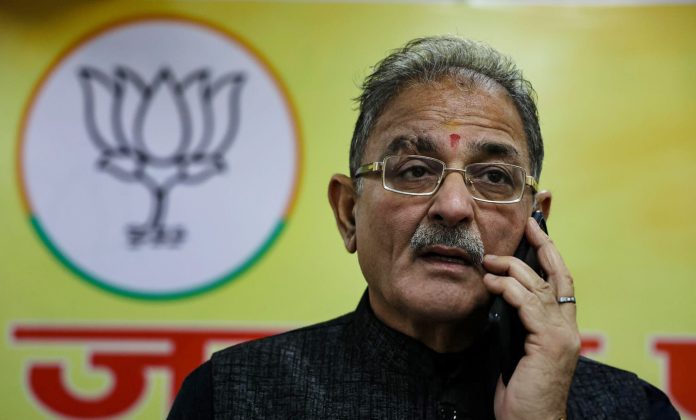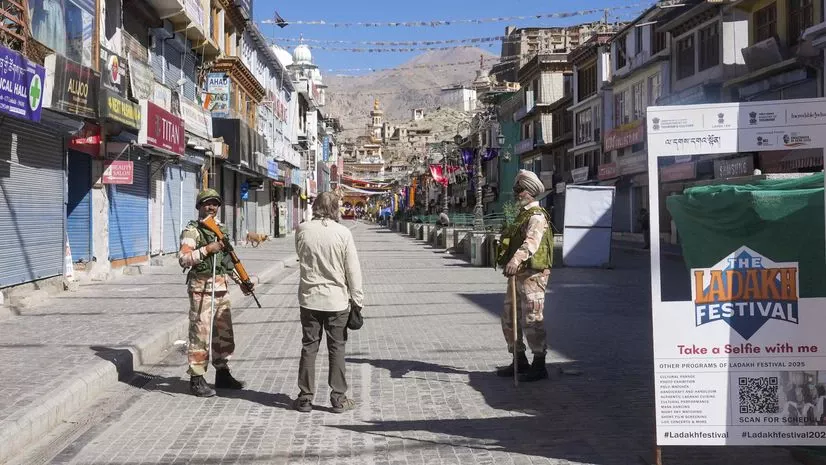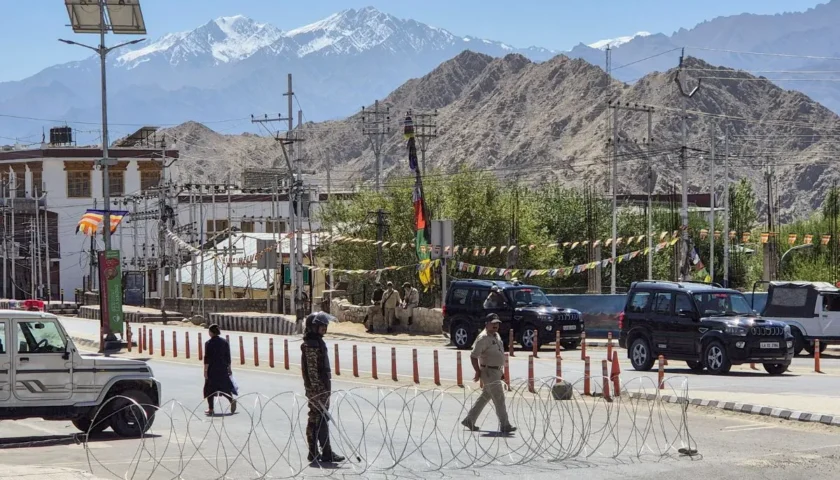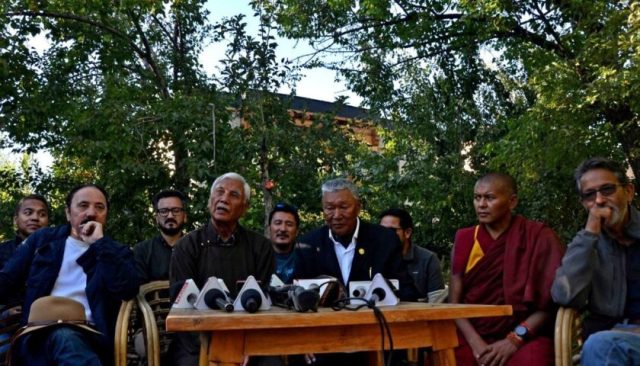Former J&K Deputy CM Kavinder Gupta becomes Ladakh’s new LG. His appointment brings political weight amid demands for Sixth Schedule, statehood, and local empowerment.
By: Javid Amin | Srinagar | 14 July 2025
Kavinder Gupta Appointed Ladakh’s New LG: A Political Strategist Steps In
In a key administrative reshuffle with long-term regional implications, Kavinder Gupta, senior BJP leader and former Deputy Chief Minister of Jammu & Kashmir, has been appointed as the new Lieutenant Governor of Ladakh. His appointment follows the resignation of Brigadier (Retd.) B.D. Mishra, who held the post since 2023.
The development comes at a crucial time when Ladakh’s political aspirations—including Sixth Schedule protection, statehood, and electoral representation for both Leh and Kargil—are at the forefront of national discourse.
Who Is Kavinder Gupta? A Profile in BJP-RSS Cadre Politics
Political Rise
Kavinder Gupta is a veteran RSS pracharak turned seasoned BJP leader with over two decades of experience in public life.
-
Mayor of Jammu (2005–2010): He became the first elected mayor of Jammu Municipal Corporation and served three consecutive terms—a rare feat in urban governance.
-
Speaker, J&K Legislative Assembly (2015): Post the 2014 assembly elections, Gupta was elected Speaker of the J&K Assembly during the BJP-PDP coalition government.
-
Deputy Chief Minister (2018): After a cabinet reshuffle in the PDP-BJP alliance, he was appointed Deputy CM, replacing Nirmal Singh.
Political Orientation and Style
-
Known for his grassroots connect and disciplined RSS background.
-
Consistently projected as a moderate voice within BJP, advocating inclusive development across Jammu, Kashmir, and Ladakh.
-
Has often emphasized “regional equity”, cautioning against policies that alienate specific subregions of J&K.
The Transition: From B.D. Mishra to Kavinder Gupta
B.D. Mishra: Military Discipline, Limited Political Acumen
Brig. B.D. Mishra (Retd.), a decorated army officer, was seen as a no-nonsense administrator, but with limited political bandwidth to handle Ladakh’s increasingly complex civil society demands.
-
His tenure saw administrative consolidation but growing alienation among local groups, particularly the Leh Apex Body (LAB) and Kargil Democratic Alliance (KDA).
-
Critics argue that the Centre’s promises post-Article 370—especially regarding autonomy and tribal rights—remained unfulfilled, leading to multiple joint agitations in Leh and Kargil.
Why the Change?
The appointment of Gupta signals a shift from bureaucratic to political leadership, indicating that Delhi wants dialogue, not just direction, in Ladakh.
Why Gupta’s Appointment Matters: Ladakh’s Volatile Political Landscape
The timing of Kavinder Gupta’s appointment is not coincidental. It comes amid:
1. Rising Demand for Sixth Schedule Protection
The Leh Apex Body (LAB) and Kargil Democratic Alliance (KDA) have jointly demanded Sixth Schedule status under the Constitution, which would:
-
Protect tribal identity and land rights
-
Ensure autonomous local governance
-
Safeguard cultural and linguistic heritage
Despite initial assurances from Home Minister Amit Shah in 2019, there has been little progress, triggering frustration in both Leh and Kargil.
2. Statehood and Full Legislature
Activists and political groups argue that the Union Territory model has weakened local democratic accountability.
-
Unlike J&K, Ladakh has no legislative assembly, making it entirely dependent on bureaucratic decisions.
-
Gupta’s political credentials may help bridge the gap between civil society and the Centre, especially if dialogue on full statehood or legislature gains traction.
3. Electoral Imbalance: Leh vs. Kargil
The demand for separate Lok Sabha constituencies for Leh and Kargil stems from political and cultural divergence between the two districts.
-
Leh is Buddhist-majority and traditionally pro-BJP.
-
Kargil is Shia Muslim-majority, with strong anti-BJP sentiments.
Navigating this sectarian and electoral divide will be a major test for Gupta.
Key Challenges Ahead for Kavinder Gupta
1. Infrastructure and Climate-Sensitive Development
While road and tunnel projects are booming post-2019, there are rising concerns about ecological sustainability, water scarcity, and climate impacts.
-
Projects like the Zojila Tunnel and Srinagar-Leh rail link offer strategic value but also raise environmental alarms.
-
Gupta will need to ensure people-centric, sustainable development that balances national interests with local sensitivities.
2. Rebuilding Trust with Civil Society
Gupta inherits a region disillusioned by broken promises.
-
Joint agitations by the LAB and KDA—rare in Ladakh’s political history—signal deep-rooted frustration.
-
His political background could allow real-time, credible dialogue, unlike military or bureaucratic predecessors.
3. Asserting Political Relevance Amid Delhi’s Control
As LG, Gupta will operate under the direct supervision of the Union Home Ministry.
-
Can he carve out autonomy in decision-making?
-
Will he be allowed to engage meaningfully with dissenting groups?
Much will depend on how much political space Delhi is willing to allow him—and how skillfully Gupta navigates those boundaries.
What This Signals for the BJP
1. Strategic Consolidation Before Elections
With Lok Sabha elections behind and assembly polls pending in J&K, appointing a political face like Gupta suggests BJP is planning a long-term regional strategy that extends beyond security optics.
2. Appeasement Without Concession?
While Gupta’s appointment may symbolically acknowledge Ladakh’s unrest, critics fear it could be another “cosmetic reset” without constitutional or policy-level changes.
Conclusion: Gupta’s Role—Symbolic or Substantive?
The appointment of Kavinder Gupta as Ladakh’s Lieutenant Governor is more than just a bureaucratic reshuffle—it’s a test of Delhi’s willingness to engage politically with the aspirations of a region caught between strategic geography and democratic vacuum.
His tenure will likely be closely scrutinized for:
-
Substantive engagement on Sixth Schedule and statehood
-
Balanced development without ecological degradation
-
Political inclusion across Leh and Kargil’s complex social fabric
Whether Gupta can transition from being a BJP loyalist to a Ladakhi consensus-builder will define not just his legacy, but also the Centre’s credibility in the high-altitude region.
In a land of glaciers and grievances, the new LG must walk carefully—or risk another political avalanche.




